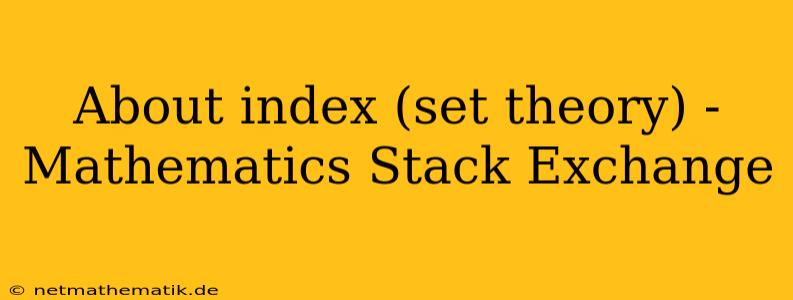In mathematics, particularly in set theory, the index of a set plays a crucial role in understanding the structure and relationships between different sets. The concept of an index allows us to systematically label elements within a set, providing a framework for organizing and analyzing its properties. This article will delve into the definition and properties of indices in set theory, exploring their applications and demonstrating their significance in various mathematical contexts.
Understanding Indices in Set Theory
An index in set theory is a way to identify and distinguish individual elements within a set. It's a mechanism that assigns a unique label or identifier to each element, allowing us to refer to them individually. To understand this better, imagine a set of fruits: {apple, banana, orange}. We can use natural numbers as indices to label each fruit:
- Apple: 1
- Banana: 2
- Orange: 3
In this case, the numbers 1, 2, and 3 are the indices, and they provide a systematic way to access and manipulate the elements of the set. This approach is particularly helpful when dealing with large sets, where it becomes cumbersome to refer to elements by their full names.
Applications of Indices in Set Theory
The concept of indices finds extensive applications in various areas of set theory, including:
1. Indexing Sets of Sets
One of the most common uses of indices is in dealing with sets of sets. Consider a set containing three sets: {A, B, C}, where A = {1, 2}, B = {3, 4}, and C = {5, 6}. We can use indices to represent each of these sets:
- A: 1
- B: 2
- C: 3
This allows us to easily refer to a specific set within the larger collection. For instance, if we want to access the second set, we can simply use its index, which is 2, and know it represents the set B.
2. Describing Sequences and Functions
Indices are fundamental in describing sequences and functions in set theory. A sequence is a function whose domain is a set of natural numbers, typically represented by the set {1, 2, 3, ...}. Each element in the sequence can be identified by its index, corresponding to its position in the sequence. For example, the sequence (1, 4, 9, 16, ...) can be represented as a function f(n) = n², where n is the index of each element.
Functions, similarly, can be defined using indices. A function f from a set A to a set B associates each element of A to a unique element of B. The index of an element in A is used to determine the corresponding element in B according to the function's definition.
3. Defining Indexed Families
Indices are crucial in defining indexed families of sets. An indexed family is a collection of sets where each set is associated with a unique index. This allows us to represent a family of sets as a single entity, making it easier to manipulate and analyze their properties. For example, an indexed family of intervals could be defined as {I<sub>n</sub>}<sub>n∈N</sub>, where I<sub>n</sub> = [n, n + 1) for each natural number n. Here, the index n is used to specify a particular interval within the family.
Benefits of Using Indices
Using indices in set theory offers numerous benefits, including:
- Organization: Indices provide a systematic way to organize and label elements within a set, making it easier to manage large sets and refer to specific elements.
- Efficiency: By assigning indices to elements, we can avoid cumbersome descriptions and perform operations more efficiently.
- Clarity: Using indices enhances the clarity of mathematical expressions and allows for precise representation of relationships between elements.
- Generalization: Indices allow for generalizations and applications to more complex mathematical structures, such as indexed families and sequences.
Examples of Indices in Action
To illustrate the practical use of indices, let's consider a few examples:
-
Power sets: The power set of a set S is the set of all subsets of S. We can use indices to represent each subset of S. For example, if S = {a, b}, its power set P(S) = {{}, {a}, {b}, {a, b}}. We can assign indices to these subsets:
- {}: 1
- {a}: 2
- {b}: 3
- {a, b}: 4
-
Cartesian products: The Cartesian product of two sets A and B is the set of all possible ordered pairs where the first element comes from A and the second element comes from B. Indices can be used to represent these pairs. For example, if A = {1, 2} and B = {3, 4}, their Cartesian product A x B = {(1, 3), (1, 4), (2, 3), (2, 4)}. We can assign indices to these pairs:
- (1, 3): 1
- (1, 4): 2
- (2, 3): 3
- (2, 4): 4
These examples demonstrate how indices can be applied to various set operations, providing a structured approach to working with sets and their elements.
Conclusion
The concept of an index is a fundamental tool in set theory, allowing us to organize, label, and manipulate elements within sets. Its applications extend to various areas, including indexing sets of sets, describing sequences and functions, and defining indexed families. By providing a systematic approach to dealing with sets and their elements, indices enhance the clarity, efficiency, and power of mathematical reasoning in set theory.
